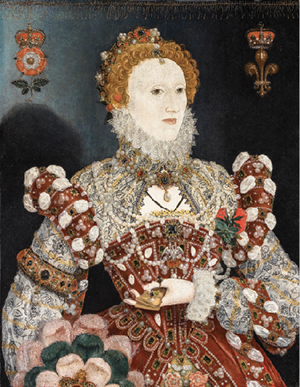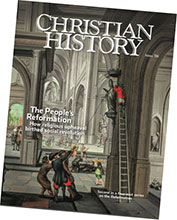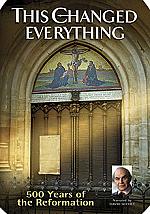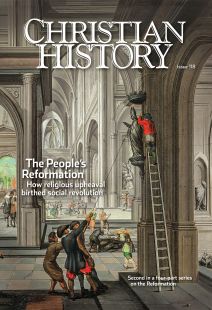The accidental revolution

BY 1530 in England, King Henry VIII (1491–1547) began to put aside the people and beliefs he had formerly trusted. His queen, Catherine of Aragon (1485–1536), was his first target, now in her forties and unable to produce the son he so desperately wanted to secure his dynasty; Henry banished her from court.
Cardinal Thomas Wolsey (1473–1530), his chancellor, a powerful prince of the church on whose shoulders the king had once placed all political and diplomatic affairs, was dismissed from public office and charged with treason. Wolsey would surely have lost his head, if he had not died while awaiting trial.
In their places the ambitious Boleyn family and the wily jack-of-all-trades Thomas Cromwell (1485–1540) rose in the king’s favor. Along with them came new ideas flooding in from the continent that offered a solution to the king’s dynastic dilemma. And more.
A king in desperate times
Desperate times called for desperate measures, and at the heart of Henry VIII’s distress was his desire for a son. Not just any male child; he had one son already, Henry FitzRoy. But as a bastard, FitzRoy was barred from succeeding to the throne. What the king needed was a legitimate male heir. Catherine had given him a daughter, Mary. But there was little history of female rule in England; the specter of the long and bloody dynastic conflict of the fifteenth century known as the Wars of the Roses frightened Henry.
He also believed that his marriage to Catherine, his brother’s widow, was a sin based on Leviticus 20:21. At the time of Henry’s marriage to Catherine, his father had secured a papal dispensation circumventing Leviticus; but the king now wondered if popes had such godly authority. Finally, Henry VIII was in love. Of course amorous adventures were nothing new for him, but Anne Boleyn (1507–1536) wanted to be queen just as much as Henry wanted a legitimate male heir.
Reformation ideas became more appealing to the king as his frustration with Rome grew. He had been seeking an annulment from Catherine since 1527, but his timing was poor. Pope Clement VII was under the thumb of Catherine’s powerful nephew, Holy Roman emperor and king of Spain, Charles V. Clement sought to appease the English king without offending the emperor. At one point an ecclesiastical court was established in England to hear the case for annulment, but nothing came of it.
The pope offered imaginative solutions. Catherine could take the veil as a nun; she refused. Henry could enter into a bigamous marriage with Anne, or marry his daughter Mary to Henry FitzRoy. But those options offered new problems—bigamy and incest—and Henry doubted the English people would accept or consider legitimate any heir produced under such circumstances.
The king appointed his friend Sir Thomas More (1478–1535) as chancellor following Wolsey’s fall. But More opposed the annulment and vigilantly prosecuted those spreading what he saw as heretical ideas. Clearly Henry needed new men willing to annul his first marriage, marry him to Anne, and legitimize the revolution by breaking England’s ties to Rome.
One-time soldier, merchant, and lawyer turned politician Thomas Cromwell was one such a man; Thomas Cranmer (1489–1556), humanist-inspired priest who had taken a wife, was another. (Cranmer’s wife, Margarete, was the niece of Lutheran reformer Andreas Osiander.)
Queen, but not for long
In 1532 Henry appointed Cranmer to the highest ecclesiastical office in England, archbishop of Canterbury. Cranmer welcomed the growing reform agenda and was more than willing to do the king’s bidding. Anne Boleyn’s pregnancy made matters urgent; Cranmer formally annulled the king’s marriage to Catherine and celebrated his marriage to Anne. He placed the crown on Anne’s head himself, making her the new queen of England.
Order Christian History #118: The People’s Reformation in print.
Subscribe now to get future print issues in your mailbox (donation requested but not required).
Meanwhile Cromwell worked to sever ties with Rome by stage-managing the “Reformation Parliament” of the early 1530s. He fed flames of anticlericalism and asserted the king’s absolute supremacy. He orchestrated debates, controlled elections to fill the seats of members of Parliament who had resigned, and bullied his opponents—and the king richly rewarded him for his services. Henry and Cromwell were also well aware of the value of propaganda; throughout the 1530s Cromwell ordered the dissemination of tracts and sermons attacking the papacy and exalting obedience to the king. By 1534 Cromwell had engineered a complete break with Rome. Parliament passed the Act of Supremacy declaring Henry VIII and his successors supreme heads of the Church of England.
Henry’s new church was fairly conservative: outwardly very Catholic in appearance and initially more Catholic than Protestant in doctrine, as the king rejected the central Lutheran tenet of justification by faith and held fast to the dogma of transubstantiation.
But those Henry had put in place around him wished to carry the revolution further. They began by assailing the cult of the saints, the veneration of images, Masses for the dead, and popular devotional practices such as pilgrimages—the kind memorialized in the popular Canterbury Tales, written more than a century earlier.
These changes transformed every English parish, but the most dramatic impact was the dissolution of the monasteries. The Crown needed money; confiscation of these religious institutions allowed the king access to the great wealth of the church in England. Between 1536 and 1541, 900 communities of religious sisters and brothers were dissolved. Many former monks and nuns returned to the villages of their birth and married, became laborers and domestic servants, or learned a trade. Some men became clergy in the new church or clerks or scribes for the wealthy. Some fled to Catholic countries. And some joined the ranks of restless drifters.
King of England, prince of humanists
These events led common folk and clergy, particularly in the conservative counties of northern England, to challenge the king’s revolution. But any defiance was firmly squashed. Henry had the support of wealthy aristocrats and gentry who quickly bought up monastic lands and houses and became even more invested in the Reformation’s success.
But their support went beyond the acquisition of real estate. Many educated men and women and wealthy townsfolk sympathized with Protestant leaders on the continent. Like the king himself, they were educated in the ideals of Renaissance humanism, which placed a premium on critical inquiry. Under such intense scrutiny, the Catholic Church rarely came out smelling like a rose. William Tyndale (1494–1536), More, and Henry himself all received keenly the critical ideas of Erasmus, the “prince of the humanists.”
More was a lawyer and politician. He was also deeply spiritual, occasionally practicing ascetic exercises such as self-flagellation. Yet he had a wry sense of humor and a love of life, and he was an affectionate father who provided his daughters with a thoroughly humanist education. He was also one of Erasmus’s dearest friends. They met in England and became lifelong correspondents; when Erasmus was in England, he had his own room at More’s house. Erasmus’s most famous work, Praise of Folly (1511), was inspired by More and dedicated to him.
Praise of Folly humorously lambastes incessant and destructive warfare perpetuated by Europe’s princes, money-grubbing merchants who overcharged their customers, and unscrupulous lawyers who fed off their clients like lice. But Erasmus saved his harshest criticism for the Catholic Church—especially its theologians, monks, and popes, whom he saw as forgetting the message of the Gospels and crucifying Christ afresh by their scandalous lives.
Erasmus’s satiric critique of the church was friendly fire, though. He wanted it reformed from within, not pulled asunder by the likes of Luther and other Protestant leaders. More agreed. He too composed a famous work of social criticism and satire, Utopia (1516). And he too remained faithful to Rome, though it cost him his life.
More resigned his chancellorship in 1532; the king’s desire for an annulment and breaking ties with Rome made his position untenable. In 1535 he was charged with treason for his unwillingness to take the Oath of Supremacy acknowledging Henry’s sovereignty over the church in England. As he was beheaded on July 6, More reportedly described himself as, “the king’s good servant, but God’s first.”
Others used the humanist critique of Catholicism as a stepping stone toward Protestantism. Oxford scholar Tyndale was influenced by the work of Erasmus (particularly his translation of the New Testament) and was also impressed by Lutheran challenges to Catholic theology. In 1523 Tyndale sought to translate the Bible into English but was denied permission to do so in England.
The traveling Bible translator
Tyndale went to Europe, traveling through the Low Countries and northwest Germany—all in the full throes of the Reformation. Evangelical zeal infused his translation, the first in over 150 years. Copies of it were already circulating in England by 1527, well before Henry’s break with Rome, creating a popular surge for reform among educated men and women. Its language was accessible and powerful; Tyndale laid the basis for all subsequent English translations and crafted familiar phrases such as “lead us not into temptation but deliver us from evil.”
But Tyndale refused to sanction the king’s desire for an annulment, not out of any love for Catholicism but rather on scriptural grounds. Henry had him tracked down, tried for heresy, and executed just outside Brussels in 1536: strangled to death at the stake and his body burned. Ironically the English Bible the king and Cromwell ordered in 1538 to be bought and displayed by every parish in England was based on Tyndale’s translation.
The English Reformation was full of violent ends. Henry had Anne Boleyn beheaded by sword in 1536 on trumped-up charges of witchcraft and adultery. Her real crime was her failure to produce a son. Ironically she did give him a healthy daughter, the future Queen Elizabeth I (1533–1603), often considered the greatest monarch in English history. Thomas Cromwell met his demise in 1540 for arranging the king’s marriage to his fourth wife, Anne of Cleves; Henry found her unappealing and never consummated the marriage. And while Thomas Cranmer survived Henry’s reign and the short reign of his son by Jane Seymour, Edward VI (1537–1553), he was burned at the stake in 1556 by Henry’s Catholic daughter, Mary (1515–1568).
The new Church of England survived. Even by the end of Henry’s reign, Protestantism was taking hold among the people, especially among the youth who enjoyed smashing images and repudiating old practices to which their parents often clung in secret.
Under Edward, the church lurched forward in the direction of Protestantism in ritual and doctrine. Mary, his half-sister, persecuted reformers, endowing the English reformation with a history of suffering that gave it incredible appeal and power. Under Elizabeth the Church of England strove to find a via media (“middle way”) between Catholicism and a more thorough-going Puritanism. To this day Anglicanism, as it has come to be called, has maintained this third position. CH
This article is from Christian History magazine #118 The People’s Reformation. Read it in context here!
Christian History’s 2015–2017 four-part Reformation series is available as a four-pack. This set includes issue #115 Luther Leads the Way; issue #118 The People’s Reformation; issue #120 Calvin, Councils, and Confessions; and issue#122 The Catholic Reformation. Get your set today. These also make good gifts.
By Melinda S. Zook
[Christian History originally published this article in Christian History Issue #118 in 2016]
Melinda S. Zook is professor of history at Purdue University and author of Radical Whigs and Conspiratorial Politics in Late Stuart England and Protestantism, Politics and Women in Britain, 1660–1714.Next articles
A motley, fiery crew
Sometimes difficult, always committed, these men advanced the Reformation in Germany, Switzerland, and England
David C. Steinmetz and Edwin Woodruff TaitThe people's Reformation: Recommended resources
Where can you go to learn more about the “people’s Reformation”? Here are some recommendations from CH editorial staff and this issue’s authors.
the editorsSupport us
Christian History Institute (CHI) is a non-profit Pennsylvania corporation founded in 1982. Your donations support the continuation of this ministry
Donate







